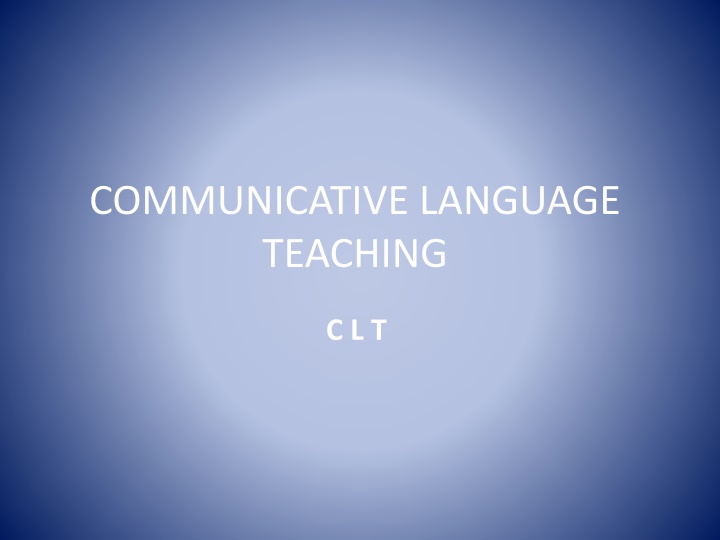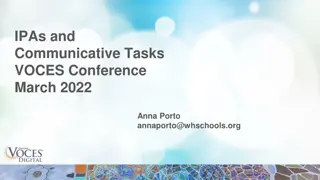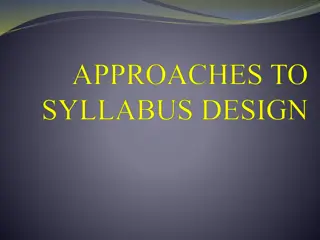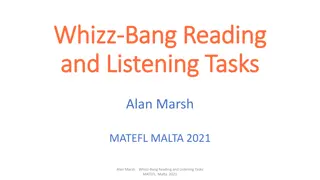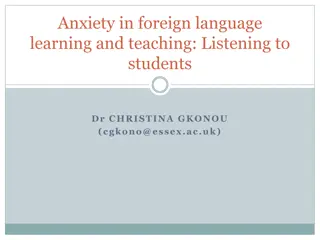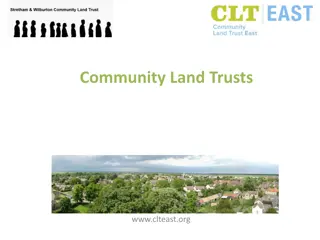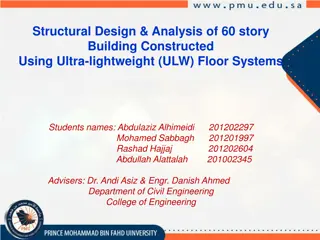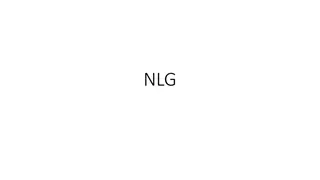Principles of Communicative Language Teaching (CLT)
Communicative Language Teaching (CLT) emphasizes the importance of enabling students to communicate in the target language effectively in real-life situations. This approach focuses on developing linguistic competence and communicative competence to ensure learners can use the language proficiently. The method involves teacher objectives, roles of teachers and students, and characteristics of the teaching and learning process such as information gap, choice, and feedback.
Download Presentation

Please find below an Image/Link to download the presentation.
The content on the website is provided AS IS for your information and personal use only. It may not be sold, licensed, or shared on other websites without obtaining consent from the author.If you encounter any issues during the download, it is possible that the publisher has removed the file from their server.
You are allowed to download the files provided on this website for personal or commercial use, subject to the condition that they are used lawfully. All files are the property of their respective owners.
The content on the website is provided AS IS for your information and personal use only. It may not be sold, licensed, or shared on other websites without obtaining consent from the author.
E N D
Presentation Transcript
COMMUNICATIVE LANGUAGE TEACHING C L T
INTRODUCTION Previous language teaching methods are thought to be inadequate to teach learners using the target language to communicate in real situations outside the classroom. It is important the foreign language learners are enabled to use their linguistic competence ( knowledge about communicative competence ( knowing what and how to say what to whom ) in communication in real life situations. language ) and the
PRINCIPLES 1. Teacher s Objectives : To enable students to communicate in the target language through knowing language ( forms, meanings and functions ) and knowing how to make use the appropriate language forms in different social functions.
2. Teachers / Students Roles : Teacher s Role : At the beginning of the class, the teacher is a facilitator ( sets up the situation through which the students would communicate ) During the activities, the teacher is : Advisor ( answering students questions ) Monitor of the students performance Noting students errors in order to work on them later on through certain activities he/she designs
Co communicator : the teacher may participate in the communicative activity with the students Students Roles : The main role is communicators ( actively participating in the communicative activities to make themselves understood despite heir incomplete knowledge ) Responsible for their own learning as the class is not teacher-centered
3. Characteristics of the teaching / learning process : Morrow ( 1981 ) states that communicative activities have three features : 1. Information gap : It exists when one person in an exchange knows something the other person does not know. It is different from display questions in which the teacher ask the students to display their knowledge, but not to give information
2. Choice : The speaker has the choice of what to say and how to say it. 3. Feedback : A true communication should have a purpose. The speaker can evaluate whether the aim of the communication has been achieved or not depending on the information received from the listener. Other features are : Authentic Materials / Situations Students work in pairs groups
4. Interaction : The teacher starts the interaction when setting the communicative situation. During the activities, there is T S interaction when the teacher functions as co-communicator. Most of the interaction in the class should S S .
5. Students Feelings : Students are motivated to learn when they find what they are learning is something useful Teacher must give the students the chance to express their ideas and opinions Security is enhanced through the group work
6. How is language / culture viewed? Language is for communication Both of linguistic competence and communicative competence are necessary for communication Communication requires knowledge of language forms with their meaning and functions. Culture is the lifestyle of the language native speakers. Learners should be aware of the fact that communication is not done through language only, but there is what is called nonverbal communication
7. Language Components / Skills emphasized : Language functions are emphasized over form ( functional syllabus ) For beginners, simple forms are presented. But with advanced students, language is taught according to its functions Students work with language at the discourse or suprasentential level ( cohesion & coherence ) All four skills are emphasized
8. Role of Native Language : The learners native language should only be used when it is necessary. The target language must be the only one used in the class. It should not only be used in the activities, but also in giving instructions and assigning homework as this is considered a type of exchange. This would help the students understand that communication, and not only an object to be studied. language is for
8. Evaluation : Evaluation should be for students fluency and accuracy Informal evaluation can be done through the activities Formal evaluation can be done through integrative tests as long as it is communicative
10 . Error Correction : For beginners, fluency is important. So, errors should be tolerated . The teacher must note down his / her students language errors to be worked on them later in accuracy based activities.
TECHNIQUES Authentic Material Scrambled Sentences Language Games Picture Strip Story Role - Play
